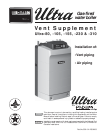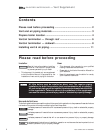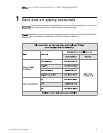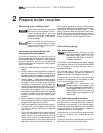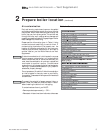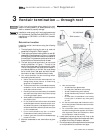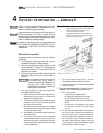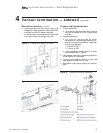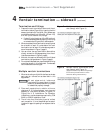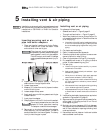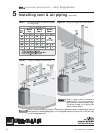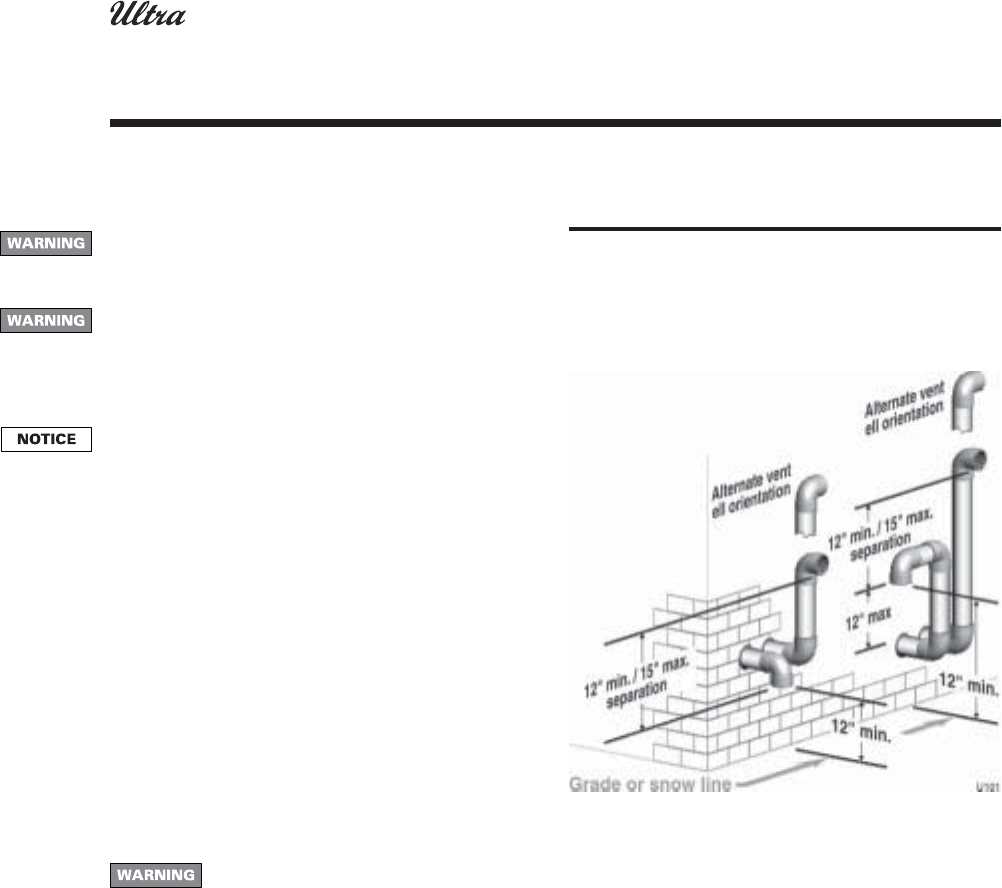
Part number 550-101-235/0903
8
GAS-FIRED WATER BOILER — Vent Supplement
Vent/air termination — sidewall4
Determine location
Locate the vent/air terminations using the following
guidelines:
1. The total length of piping for vent or air must not
exceed the limits given in Table 2, page 12.
2. The air piping must terminate in a down-turned
elbow as shown in Figure 3. This arrangement
avoids recirculation of flue products into the
combustion air stream.
3. The vent piping must terminate in an elbow pointed
outward or away from the air inlet, as shown in
Figure 3.
Do not exceed the maximum lengths of
the outside vent piping shown in
Figure 3. Excessive length exposed to the
outside could cause freezing of
condensate in the vent pipe, resulting in
potential boiler shutdown.
4. You must consider the surroundings when
terminating the vent and air:
a. Position the vent termination where vapors will not
damage nearby shrubs, plants or air conditioning
equipment or be objectionable.
b. The flue products will form a noticeable plume as they
condense in cold air. Avoid areas where the plume
could obstruct window views.
c. Prevailing winds could cause freezing of condensate
and water/ice buildup where flue products impinge
on building surfaces or plants.
d. Avoid possibility of accidental contact of flue products
with people or pets.
e. Do not locate the terminations where wind eddies
could affect performance or cause recirculation, such
as inside building corners, near adjacent buildings or
surfaces, window wells, stairwells, alcoves, courtyards
or other recessed areas.
Follow instructions below when determining vent
location to avoid possibility of severe personal injury,
death or substantial property damage.
A gas vent extending through an exterior wall shall not
terminate adjacent to the wall or below building
extensions such as eaves, parapets, balconies or decks.
Failure to comply could result in severe personal injury,
death or substantial property damage.
Installation must comply with local requirements and
with the National Fuel Gas Code, ANSI Z223.1 for U.S.
installations or CSA B149.1 or B149.2 for Canadian
installations.
f. Do not terminate above any door or window.
Condensate can freeze, causing ice formations.
g. Locate or guard vent to prevent condensate damage
to exterior finishes.
5. Maintain clearances as shown in Figures 3, 4, and 5,
pages 8, 9 and 10. Also maintain the following:
a. Vent must terminate:
• At least 6 feet from adjacent walls.
• No closer than 5 feet below roof overhang.
• At least 7 feet above any public walkway.
• At lease 3 feet above any forced air intake within
10 feet.
• No closer than 12 inches below or horizontally
from any door or window or any other gravity
air inlet.
b. Air inlet must terminate at least 12" above grade or
snow line; at least 12" below the vent termination;
and the vent pipe must not extend more than 24"
vertically outside the building as shown in Figure 3.
c. Do not terminate closer to 4 feet horizontally from
any electric meter, gas meter, regulator, relief valve
or other equipment. Never terminate above or below
any of these within 4 feet horizontally.
Figure 3 Sidewall termination of air & vent:
(Apply left illustration unless air termination ell
would not provide the minimum 12 inch
clearance to grade or snow line.
Apply right illustration for other applications,
where exit openings are too low to provide the
minimum 12 inch clearance.)



